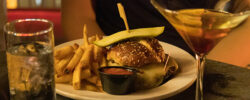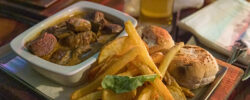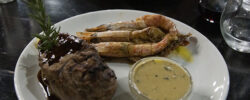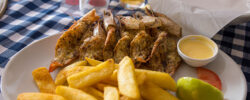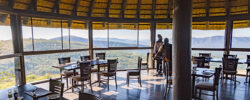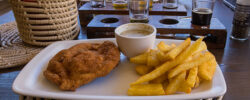When we first arrived in Durban, we took the coastal Highway 2 up the Eastern Cape, past Richards Bay. As we passed through the minor town of KwaMsane around 4pm local time, we noticed a stretch of highway where several dozen groups had all set large cooking fires with metal pots, and were preparing meals, many of them preparing to sell them roadside. The food wasn’t ready yet, and we were actually in a bit of a hurry to get to the Zulu Nyala lodge, but I was curious. Several days later, talking to our Zulu Nyala guide, he told me that what they were preparing was a local dish, “Inyama yenhloko”, which means, literally, “head meat”. It’s a traditional Zulu dish, especially for special occasions and for the head of the family, although it’s gotten broader acceptance more recently. The process is simple: fresh bovine heads are collected, they skin the heads, cleave the meat off the skulls (usually with an axe), and boil the meat in large pot of salted water, along with some cornmeal bread. It’s then all chopped up, lightly seasoned with a seasoning mix, and served on a wooden board with salt, pepper, and chiles. I was intrigued, but our travel plans didn’t have us driving down any Zulu-region highways at dinner time. But our last full day in Durban had us taking a Cultural Walking Tour of Durban run by a local named Johnny, who showed us many of the various cultural aspects, and sometimes the grittiness, of Durban. It was a very insightful tour, and after seeing the Durban skyline, and visiting several of the area markets, he took us to a very special niche market right outside the Early Morning Market: the very aptly-named Bovine Head Market.

